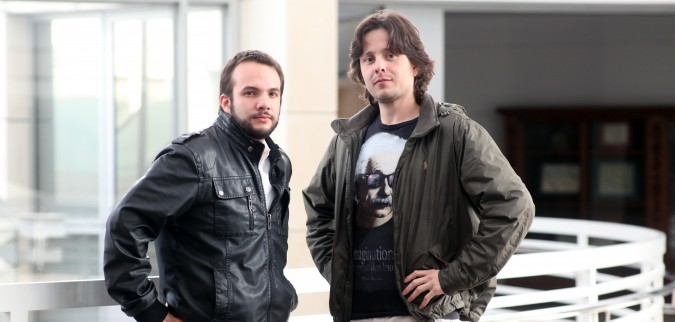Archive for the ‘Microsoft’ tag
I met with startup advisor John Matthesen, mentor to HARBO Technologies in the 2012 UC Berkeley Startup Competition
I enjoy blogging.
I am enjoying it more all the time for it affords me the opportunity to sit down and talk with interesting people.
When I covered the Berkeley Startup Competition (prior to 2012 known as The Berkeley Business Plan Competition) on April 26, 2012, I introduced myself to John Matthesen. Matthesen was assigned this year to mentor HARBO Technologies, which won the Energy and Clean Tech (archived version for use if previous link breaks in the future — 2012 Berkeley Startup Competition winners list) track of the competition with its innovative system to greatly reduce the environmental impact of oil spills in bodies of water.
I met Matthesen while I was waiting in line to introduce myself to HARBO’s CEO Boaz Ur.
I told both Ur and Metthesen that I’d like to interview HARBO for my blog. Since HARBO has invented new technology, they’re not yet ready for press coverage, as they’re still working on the legal issues, Matthesen explained by email. But he said I could interview him individually so long as we didn’t discuss HARBO. Matthesen struck me as an interesting guy I should meet in any event, so I took him up on his offer.
I met John Matthesen for coffee at the trendy ZEB Cafe at the University of California Berkeley Law School at 2745 Bancroft Way, Berkeley, California USA. According to Matthesen’s website for his company Related Concepts, he helps companies with interim management, qualitative customer research, business process development, team building and coaching, and finally, board of directors / advisory boards. I confined my questions to his background and his work as a mentor.
We jumped around to a lot of topics, never really finding a theme for this post — it didn’t seem right to talk about the past companies he’s mentored for the Berkeley Startup Competition without getting the permission from those teams.
I do feel comfortable saying that two years ago Matthesen was mentor to the winner of the 2010 Products & Services Track, BrightSense, which, according the Berkeley competition’s website:
“… uses a novel patent-pending drug delivery technology to design customized whitening strips with peroxide dosages optimized for each user’s teeth.”
There is more information about BrightSense in the University of California 2010 Berkeley Business Plan Competition booklet.
Matthesen has been fortunate to advise two winning teams.
I asked Matthesen how he got to be asked to be a mentor in the Berkeley Startup Competition. He wasn’t sure, but speculated it had to do with his background at Sybase and Commerce One.
Matthesen was an early employee at Sybase, one of the early pioneers in the database market. Microsoft licensed Sybase to form the basis of Microsoft SQL Server, still Microsoft’s sole enterprise database product. Matthesen had worked in Information Technology role at a hotel in Hawaii, and the hours were brutal. The hours Sybase told its new hires they would be expected to work were long as well, but less intense that what he endured in Hawaii. Matthesen intended to stay at Sybase just 6 months, but instead stayed for 7 years, through their initial public offering of stock. Sybase today is owned by SAP.
After Sybase, Matthesen went to Commerce One, early enough to ride the first dot com boom up to its height, and for long enough to witness the carnage of the boom’s aftermath — another seven years.
After 14 years of intensity at Sybase and Commerce One, Matthesen was ready for a break, so he turned down an early job at Google, which sadly presumably cost him millions of dollars. Ouch!
I asked Mattesen if he knew David Henderson, but he didn’t. I hired Henderson to work with me for a little over a year at my first Internet company, Hotpaper.com, Inc., and his next job was at Commerce One.
While researching this post, I discovered that Commerce One is still in business, though it’s an invisible shadow of its former self. Congratulations to the team for staying in business given the turmoil along the way.
Matthesen entertained me with crazy stories of the stock price of Commerce One shooting past USD $1,000 per share and then collapsing to zero. Matthesen advised the Commerce One CEO to ‘buy something big’ of real value, but his advice was rebuffed. The companies Commerce One could have bought at the peak of its power as a public company are still large household names deeply embedded into the daily fabric of the planet.
Matthesen told me he managed his personal finances during that crazy boom time such that he could pay his Alternative Minimum Tax bill, when his colleagues and friends were going bankrupt over their huge AMT bills in the many millions of dollars.
Young entrepreneurs in today’s boom may not be familiar with how unfair United States tax policy was during the first boom. If one exercised stock options but didn’t sell the stock right away, there was a big risk that the stock would go down by the time you sold the stock. The AMT tax was applied to the paper gain you made when you exercised the stock, and if the stock collapsed before you could sell it, you still owed tax on the paper gain. Think of the devastation if you had a USD $100,000,000 paper gain and the stock dropped to zero before you sold it. You would owe AMT tax on the $100,000,000 even though you never touched the cash.
I haven’t paid much attention recently to this AMT trap, and I never got caught in it when I sold Hotpaper, as I never held options, just common stock.
I learned from Matthesen that the AMT trap in 2009 was partly fixed, retroactively. People who were ensnared in the early 2000s were able to apply for relief and get huge sums back from the United States Treasury.
I don’t want to take on the responsibility to accurately summarize the tax relief, so I direct you to this article on the subject.
I spoke with Matthesen for less than an hour, and mostly we shared war stories. After I interview Boaz Ur of HARBO, I’ll likely have more to say. Until then, have a look at the pictures I took of Matthesen at the conclusion of our conversation, above.
ClasesD is SkillShare.com for Mexico
On Friday, March 16, 2012, I attended the first ‘graduation’ of the first ‘class’ of companies funded by the new seed stage venture capital firm mexican.vc. mexican.vc is run by four sharp General Partners — David Weekly, Santiago Zavala, Lisa Seeman and César Salazar.
mexican.vc has signed up prominent mentors to help, including Dave McClure, the founding partner of 500 Startups.
After the presentations, the teams dispersed around the conference room at Microsoft’s office at 835 Market Street in San Francisco, California USA. There were seven teams altogether. Three of the teams were set up along the left wall and three of the teams were set up against the right wall.
I introduced myself to and interviewed all those teams on Friday, and I wrote a long blog post about them that night.
What I didn’t know at the time was that the seventh team had set up their station up front in the room, where there was not a table, but a podium. That arrangement never registered with me that day, even though I had several lengthy conversations with people by that podium after the presentations. I didn’t know a team was there engaging with attendees. So that team, ClasesD, missed out on the commentary I wrote for my Friday blog post.
I was upset that I missed a team, so I wrote in that Friday post that I was willing to meet with the team I overlooked. The team found my blog post and reached out to me via my Facebook page.
I met the team yesterday afternoon, March 18, 2012, and we had an enjoyable meeting at the San Francisco Main Branch library at Civic Center in the City. I signed out one of the glass work rooms on the 4th floor so that we could talk without disturbing others.
Luis Enrique Aguilera and José Eduardo González described their company to me, and I had time to ask questions.
Before I get into my remarks, here is what the website for mexican.vc has to say about ClasesD:
“Interested in learning Spanish? Want to take yoga during your lunch break? You are in the right place! ClasesD is a marketplace for in-person lessons taught by independent professionals. Earlier this year when founder Eduardo was looking for dance lessons for his sister, he realized there must be a better way to advertise classes than flyers tacked on corkboards around town. Now, his team is helping people craving for knowledge find the right tutor in their city.”
Here are my comments about ClasesD:
ClasesD is SkillShare for Mexico. This is my observation, not something I heard from Aguilera or González. SkillShare is based in New York City, USA, and they have raised millions of dollars to pursue their business.
Although comparisons to airbnb have grown somewhat tiresome, such a comparison to ClasesD is inevitable. airbnb turned everyone that’s not homeless into a potential operator of a bed and breakfast. SkillShare and ClasesD turn everyone into a potential operator of a one teacher school.
If you’re a good cook, musician, painter, photographer, writer or mathematician, you can list your qualifications on ClasesD by creating a profile. Potential students can browse listings and read about the widely varied offerings. Of course, classes can be about anything, not just the example subjects I listed in this paragraph. Teachers set their own prices.
Students indicate their interest in a class and then the ClasesD website connects teacher and student together by telephone. This gives the teacher an opportunity to sell themselves to the student to increase the chances that prospects become customers. This highly personalized sales process might be unwieldy at scale, but I think it’s preferable in these early stages where the parties are still getting used to having an online marketplace to find each other in Mexico.
ClasesD makes money by charging a fee, currently 100 pesos (USD $7.93 at today’s exchange rate), to the teacher for providing the lead. Teachers keep all of the fee that they charge to attend their classes.
mexican.vc graduated 7 teams on Friday, including Fontacto. As I wrote in Friday’s post, Fontacto is Ring Central for Mexico. Fontacto helps small organizations appear big by offering a virtualized phone system that in its physical version is generally too costly to purchase and install at the organization. In a bit of portfolio company collaboration that would make any investor proud, ClasesD is a savvy consumer of Fontacto’s impressive telephony services.
One of the many impressive features offered by Fontacto is the ability to set up apparently numerous extensions on one physical telephone number.
ClasesD publishes a Fontacto powered phone number for students to call teachers on. Each teacher has an assigned extension number in the Fontacto system. Student’s calls are routed to the teacher, who can answer on whatever phone is most convenient at the time, including their mobile phone or their Skype connection. All the teacher’s assigned devices ring simultaneously, I presume, since that’s one of the features offered by Fontacto, and it makes sense to enable it for this application, where the students are probably most likely to become paying students if they reach the teacher on the first attempt.
ClasesD has a chicken and egg dilema — they need lots of teachers before they can get lots of students, but it’s tough to get lots of teachers until they have lots of students.
Marketplaces such as SkillShare and ClasesD are compelling to me. The operator of the marketplace does not have to stock and finance inventory. People expect to pay for services delivered through such marketplaces. The margins can be attractive given what needs to be done to operate the marketplace.
Aguilera and González struck me as passionate and determined. They’re learning quickly, and have tested several business models already on their search for the best model for Mexico. Their enthusiasm was evident from the moment they contacted me. I am not running TechCrunch, GigaOm or VentureBeat. I’m writing a personal blog. I will get perhaps 12,000 visitors to this site this month (I had 10,321 visitors in February, 2012). I still haven’t cracked the top million sites on Alexa. This is easy for others to check out. That Aguilera and González tracked me down and patiently explained their business to me to get a tiny amount of press shows to me that they are really trying to make ClasesD a success. They are well spoken and likable guys, and I wish them all the best.
My advice to them is to find a prove a business model that works, and then raise a million or more US dollars immediately to accelerate populating the site with more teachers and students. If you don’t solve the chicken and egg problem, a competitor will spring forth to do it for themselves, using your research to move more quickly.
Here are the biographical introductions for Aguilera and González, again from the mexican.vc website:
“Luis Enrique Aguilera graduated from ITESM Guadalajara with a B.S. in Business Administration. He is an entrepreneur, creative mind, and music aficionado. He is passionate about web marketing and SEO. He previously worked as a marketing and business consultant, which taught him to create powerful and innovative business models that he is eager to apply to his own startup.
José Eduardo González graduated from ITESM with a B.S. in Computer Science. Before founding ClasesD, he worked for 2 years as a Ruby on Rails developer in a startup called Inovaz (now a 500 startups company with their product Ovia), where he got his first taste of entrepreneurship and learned agile development practices.”
Aguilera and González graciously posed for pictures at the end of our meeting. I used the photogenic interior of the San Francisco Main Branch library as the backdrop. It was fun showing Aguilera and González around the library as this was their first visit. I attended the grand opening of the library on April 18, 1996, which featured a dramatic special delivery of the door key by skydiver Carl Prigee to Mayor Willie Brown after Prigee jumped from a biplane and landed right on target in front of the library, to the applause of the thousands gathered in attendance.




